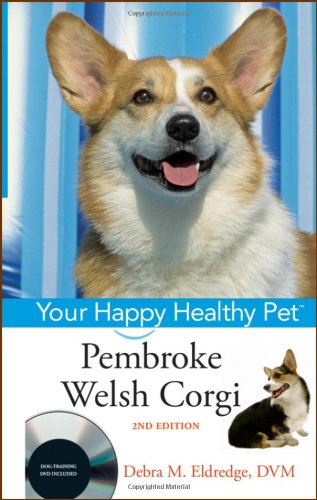
Inhaltsangabe
This fully-revised all-encompassing guide to Corgis features everything new owners need to know from preparing for the new pup to geriatric care. All new full-color photography and an included 30-minute training DVD make this a package that can't be passed up.
* Updated coverage: Comprehensive guidance and information for the Corgi owner. From understanding the breed behaviors and characteristics to choosing the right pup to grooming, feeding, and training, readers will have an all-encompassing guide.
* Assured quality: This book is ideal for a new dog owner. The all-new full-color photos create its visual appeal; the sturdy hardcover and preprinted cases produce functionality.
* Author expertise: The Happy Healthy Pet books are written by respected and established authors. Information is readable and to-the-point and presented in an easy-to-follow format.
The 30-minute dog training DVD is a perfect complement to this new edition. The DVD is made precisely for owners of medium sized dog breeds; it covers the training approach, practical commands like heeling and staying, correcting inappropriate behaviors like jumping up and chewing, fun tricks like shaking and rolling over, and a bonus chapter. This bonus chapter is unique because it is breed-specific-- a Corgi owner will learn specifically about the personality traits and habits that are characteristic of Corgis. This kind of breed-specific coverage enables owners to cater their training, care, and attention to their Corgi.
Note: CD-ROM/DVD and other supplementary materials are not included as part of eBook file.
Die Inhaltsangabe kann sich auf eine andere Ausgabe dieses Titels beziehen.
Von der hinteren Coverseite
30-minute training DVD contains bonus material specifically for your Pembroke Welsh Corgi! Dog behavioral trainer Peggy Moran shows you how properly training your Pembroke Welsh Corgi makes your best friend a Happy Healthy Pet for life.
The Pembroke Welsh Corgi is the definition of "a big dog in a small package." His legs may be short, but he's a sturdy dog who is fast, agile, and strong. Originally bred as a herding dog, the Pembroke's muscular stature and graceful gait make him a wonder to behold?while his intelligence, trainability, loyalty, and affection make him a joy to own.
Packed with full-color photographs, this fun and practical guide gives you everything you need to make your relationship with your best friend even better. Inside, you'll find:
- Characteristics to look for when choosing a Pembroke Welsh Corgi
A list of supplies you'll need before you bring him home
Advice on grooming, feeding, and training
A reproducible pet-sitter chart to keep track of important information
A bonus DVD shows you that educating your Pembroke Welsh Corgi positively is easier and more fun than you think. You'll learn how to teach your furry friend basic commands and tricks, correct inappropriate behaviors, and understand his unique personality.
Debra M. Eldredge, DVM, an award-winning writer, was the first recipient of the Gentle Doctor Award. Dr. Eldredge is a columnist for agilityaction.com and Dogs in Review. She is the author of Pills for Pets and is the coauthor of The Everything Guide to Dog Health and Cancer and Your Pet.
„Über diesen Titel“ kann sich auf eine andere Ausgabe dieses Titels beziehen.
Weitere beliebte Ausgaben desselben Titels
Suchergebnisse für Pembroke Welsh Corgi: Your Happy Healthy Pet
Pembroke Welsh Corgi
Anbieter: Better World Books, Mishawaka, IN, USA
Zustand: Good. Second. Used book that is in clean, average condition without any missing pages. Artikel-Nr. 4114879-6
Gebraucht kaufen
Versand innerhalb von USA
Anzahl: 1 verfügbar
Pembroke Welsh Corgi
Anbieter: Better World Books, Mishawaka, IN, USA
Zustand: Good. Second. Former library book; may include library markings. Used book that is in clean, average condition without any missing pages. Artikel-Nr. 5250523-6
Gebraucht kaufen
Versand innerhalb von USA
Anzahl: 1 verfügbar
Pembroke Welsh Corgi: Your Happy Healthy Pet, with DVD
Anbieter: ThriftBooks-Dallas, Dallas, TX, USA
Hardcover. Zustand: Very Good. No Jacket. Former library book; May have limited writing in cover pages. Pages are unmarked. ~ ThriftBooks: Read More, Spend Less. Artikel-Nr. G0470390611I4N10
Gebraucht kaufen
Versand innerhalb von USA
Anzahl: 1 verfügbar
Pembroke Welsh Corgi (Happy Healthy Pet)
Anbieter: AwesomeBooks, Wallingford, Vereinigtes Königreich
Hardcover. Zustand: Very Good. Pembroke Welsh Corgi (Happy Healthy Pet) This book is in very good condition and will be shipped within 24 hours of ordering. The cover may have some limited signs of wear but the pages are clean, intact and the spine remains undamaged. This book has clearly been well maintained and looked after thus far. Money back guarantee if you are not satisfied. See all our books here, order more than 1 book and get discounted shipping. . Artikel-Nr. 7719-9780470390610
Gebraucht kaufen
Versand von Vereinigtes Königreich nach USA
Anzahl: 1 verfügbar
Pembroke Welsh Corgi (Happy Healthy Pet)
Anbieter: Bahamut Media, Reading, Vereinigtes Königreich
Hardcover. Zustand: Very Good. This book is in very good condition and will be shipped within 24 hours of ordering. The cover may have some limited signs of wear but the pages are clean, intact and the spine remains undamaged. This book has clearly been well maintained and looked after thus far. Money back guarantee if you are not satisfied. See all our books here, order more than 1 book and get discounted shipping. Artikel-Nr. 6545-9780470390610
Gebraucht kaufen
Versand von Vereinigtes Königreich nach USA
Anzahl: 1 verfügbar

